
Eating for Volume: How To Make Food Work For You
Ever feel like you’re constantly hungry, even though you’re trying to stay within your calorie goals?
That’s where “eating for volume” can change the game.
This strategy focuses on eating foods that are low in calories but high in volume, so you can enjoy larger portions without blowing your calorie budget.
Think of it as getting more bang for your caloric buck!
FOR THE VISUAL LEARNER:
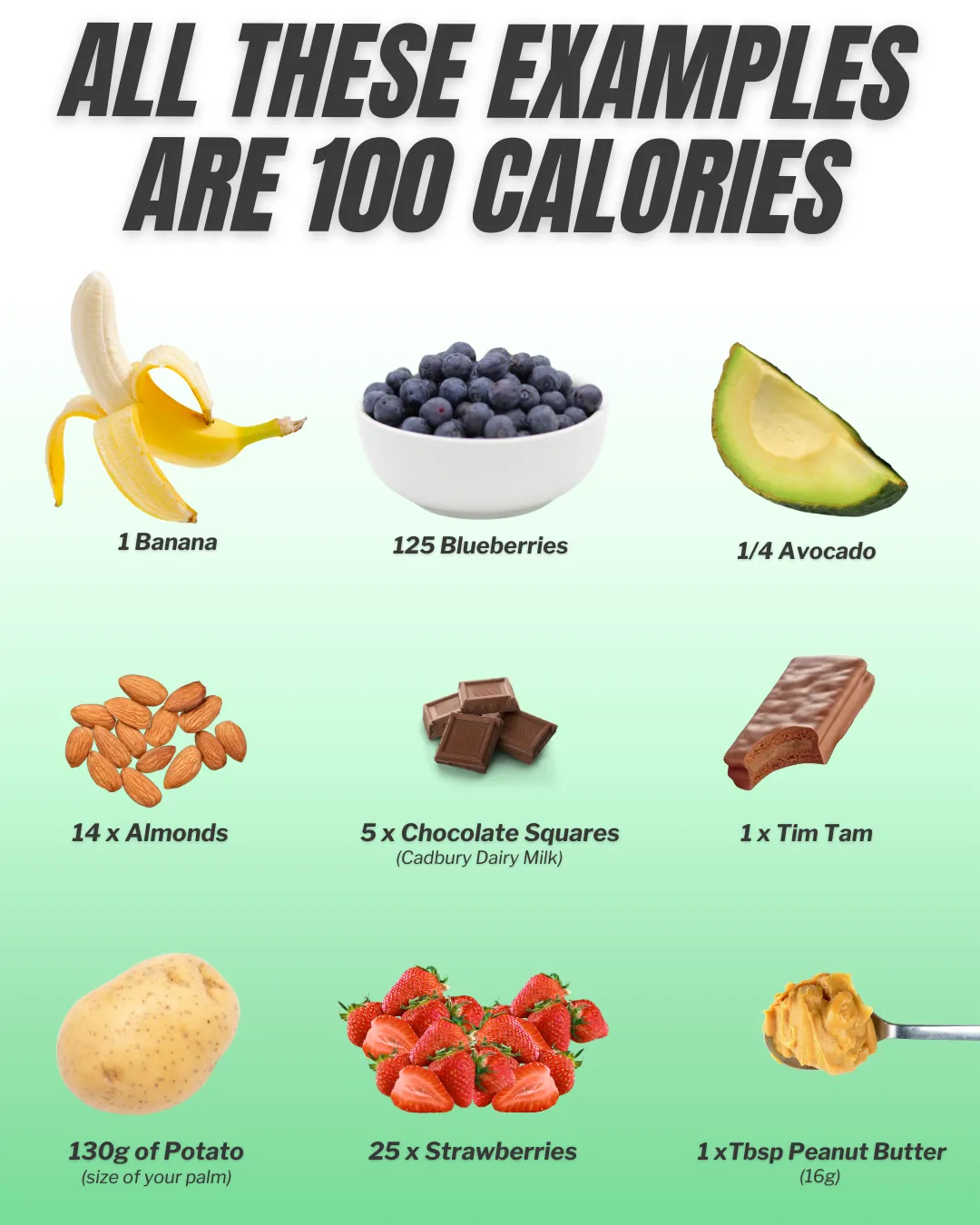

Foods like leafy greens, fruits, vegetables, and lean proteins (like fish, chicken, and tofu) have a lot of volume but won’t load you up with unnecessary calories.
These nutrient-dense options filling your stomach, helping you feel full and satisfied without the calorie overload.
Pairing protein with fiber-rich foods—like veggies or whole grains—works wonders for long-lasting energy.
You’ll feel nourished, satisfied, and still in control of your intake.
Here’s a comparison to show you what I mean.
Imagine you’re aiming for 1600 calories a day:
Option 1 - Poor Choices
Breakfast: Grab a muffin & apple on your way out the door. (300 calories minimum)
Snack: Snack on some biscuits or chips throughout the morning (100-300 calories)
Lunch: Grab some KFC: burger, chips and coke (700-900 calories)
Snack: Feeling a bit low on energy so top up with a muesli bar and handful of almonds (250 calories)
Dinner: A normal dinner with the family (around 400-500 calories)
Snack: Bit of chocolate to end the day (around 200 calories).
That's not even including coffee, tea, juices or any other drink we'd have.

We've eaten minimal protein and micronutrients, and easily gone over 2000...
Option 2 - Good Choices
With 1600 calories, you could spread your day out with high-volume, nutrient-dense meals that fill you up:
Breakfast: A big veggie scramble with egg whites, spinach, peppers, and tomatoes, plus a side of fresh berries with a coffee (around 350 calories).
Lunch: A large salad with mixed greens, grilled chicken, cucumber, carrot and more + an olive oil vinaigrette (around 350 calories).
Snack: Greek yogurt with blueberries and a Freddo Frog (about 250 calories).
Dinner: A normal dinner with the family (around 400-500 calories)
Snack: Air-popped popcorn or some strawberries with melted chocolate (around 200 calories).
And that's including your morning latte.

We've eaten plenty of protein and micronutrients, and still UNDER 1600...
The difference:
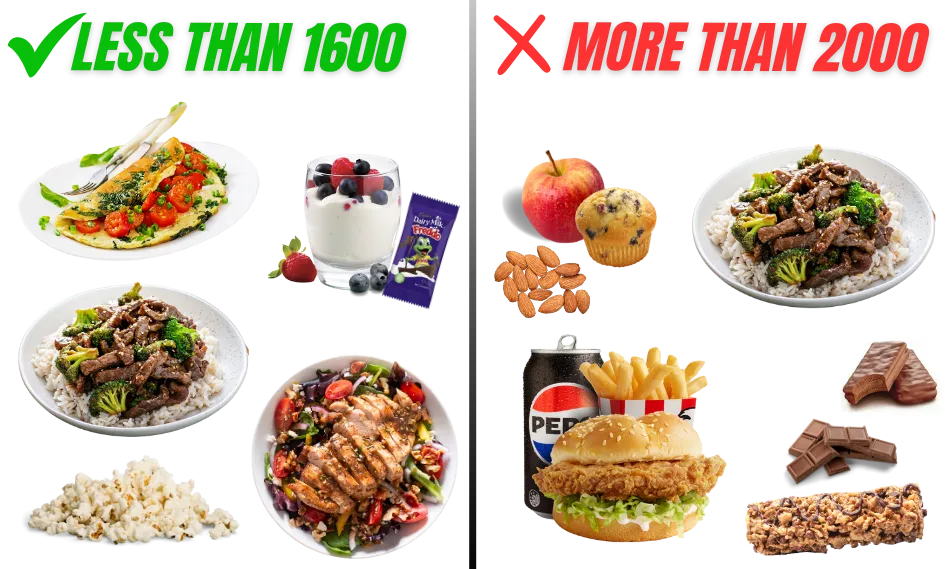
But... what if I made 'bad' choices yet i'm still below my calorie goal?
If you're deficit needs to be 1600... and you're still eating 1600 or less...
You'll still lose weight!
So... why am I telling you about the volume of food, you ask?
While it is possible to lose weight eating only chocolate & lollies 🍫🍭
The fact is... you'll feel terrible... and long term... you won't keep the weight off.
Sure, if you're eating fewer calories than you burn, you can technically lose weight by munching on nothing but chocolate bars and lollies.
But let’s be real, the results will be more bitter than sweet.
Here's why:
Energy Slumps and Brain Fog 🧠💤
Sugar highs come with epic sugar crashes. You might feel on top of the world after that chocolate binge, but soon you'll be dragging yourself through the day, unable to focus.
Hunger Strikes 🍬➡️🍔
Low nutritional foods like lollies won’t keep you full for long.
You’ll be constantly hungry because sugary snacks lack the protein, fiber, and healthy fats that keep you satisfied.
Moody Blues 😡➡️😭
Imagine being hangry all day! Sugar spikes and crashes can mess with your mood, turning you into a rollercoaster of emotions.
Gut Health?
Not So Sweet 😬 A diet full of sugar and lacking fiber will hurt your gut health.
You might find yourself bloated, uncomfortable, full of inflammation and generally leading to health issues.
Low Nutrients = Low Energy ⚡️
Chocolate and lollies don’t give your body the vitamins and minerals it needs. You'll feel sluggish, tired, and generally "meh."
And feeling like sh*t... will obviously result in us eating more and more.
Highly palatable, calorie dense foods are everywhere and accessible 24/7.
If we need to rely on sheer willpower... how long will that last when we're tired, grumpy & starving.
The Sweet Spot
So yes, while it’s possible to lose weight eating nothing but sugary treats, you'll likely feel more like a chocolate-covered zombie than a happy, healthy version of yourself.
For real, lasting energy and results, aim for a balanced diet of 80% balanced food with the 20% occasional treat... which is the next topic!
In Summary
It's important to eat for volume.
2000 calories can make you feel absolutely full.
or
2000 calories can also seem like a few small snacks.
When you're eating real, satisfying meals—veggies, lean protein, fiber, and healthy fats—we get to enjoy them in generous portions throughout the day.
This approach keeps us fuller for longer and gives us energy, while still staying within energy (calorie) needs.
Plus, you won’t be left hungry an hour after you eat!
Essentially, it makes life easier.
Now... let's talk Meal Timing.

There’s a lot of talk about the “best” meal schedule - whether it’s eating six small meals a day or sticking to two bigger ones.
But the truth is... the only thing that matters is...
Your Total Caloric Intake!
Calories do not know what time it is!
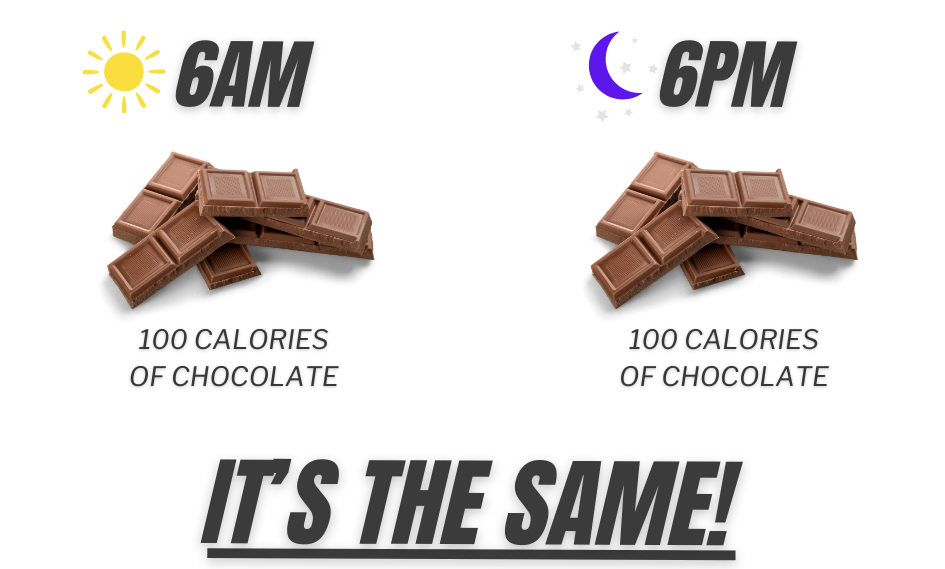
If your goal is 1600 calories a day, it doesn’t matter if you eat it all in two large meals or spread it out into five smaller ones.
When it comes to fat loss, your body only cares about the total calories.
Example:

So, why do we fast during the meal plan?
Great question!!
Essentially, it lets our body optimise everything to be more efficient & effective.
It does this by:
Resting Your Gut 🍽️➡️🛌
When you're constantly eating, your digestive system is always working. Fasting gives your gut a much-needed break, allowing the parasympathetic nervous system (aka the “rest and digest” system) to kick in and do its thing. This helps with digestion and can lead to a healthier gut lining, less bloating, and improved overall gut function.
Reducing Inflammation 🔥⬇️
Fasting has been shown to lower inflammation in the body. By reducing the frequency of meals, you're giving your system more time to repair itself and deal with inflammation. This can be especially beneficial for people with conditions like IBS or other inflammatory gut issues.
Autophagy: Cellular Spring Cleaning 🧹
During fasting, your body goes into a process called autophagy, where it cleans out damaged cells and regenerates new, healthy ones. This can reduce inflammation and help repair your gut lining, leading to improved gut health over time. This happens in any calorie deficit, even without fasting, however we've found fasting makes the deficit a lot easier to occur.
Balanced Gut Bacteria 🦠
Fasting can help balance the bacteria in your gut by reducing overgrowth of bad bacteria that thrive on constant sugar and refined carbs. This can improve digestion, nutrient absorption, and even mental health, as gut health is closely tied to brain function.
Supports Healthy Digestion 🌱
With the parasympathetic nervous system active, your body focuses more on digestion, nutrient absorption, and healing. This means that when you do eat, your body is better equipped to digest food efficiently and use those nutrients effectively.
Making results easier & faster.
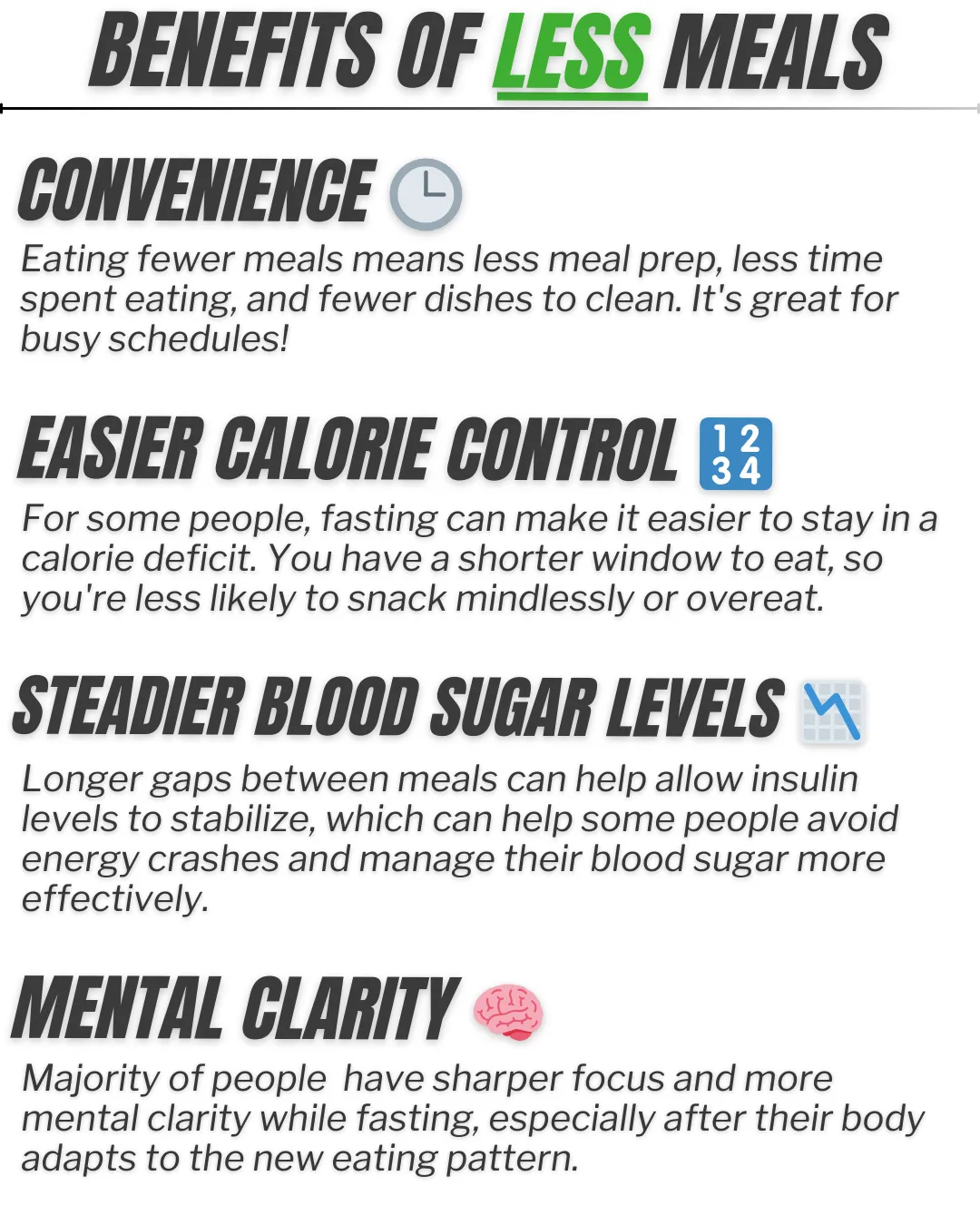

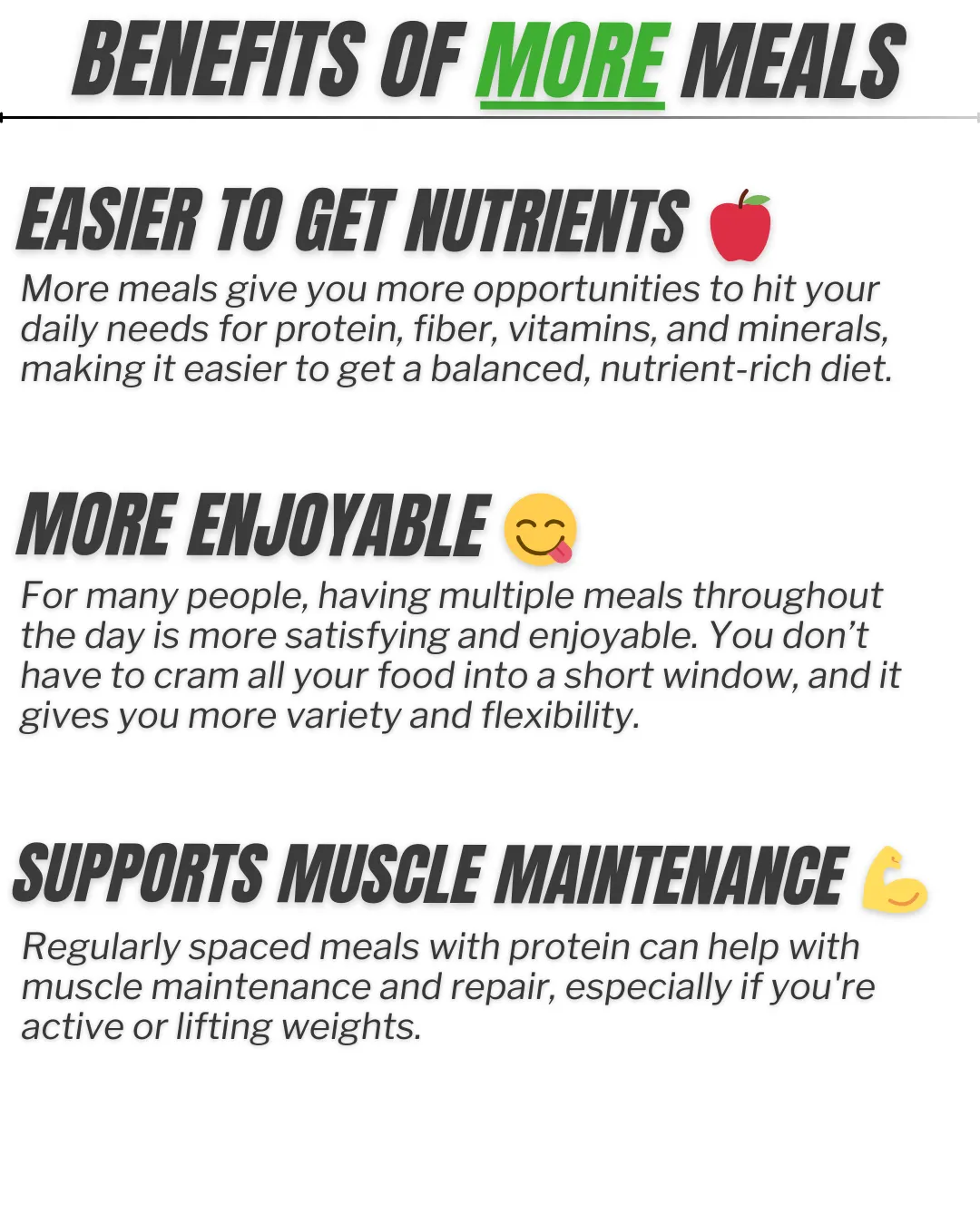
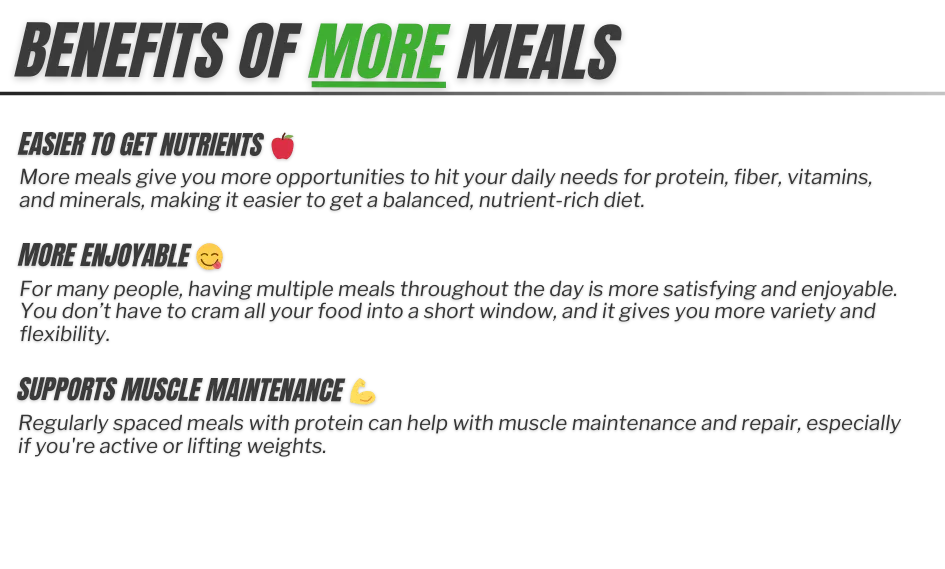
Both approaches work as long as you’re staying within your calorie goals.
Whether you’re eating two big meals or snacking more often, the key is to find what fits your routine and helps you feel satisfied.
The most important thing is that you’re consistently hitting your daily caloric needs in a way that feels good and sustainable for you.
In the end, whether you’re eating for volume or choosing your meal timing, the goal is to stay energized, feel satisfied, and stick to a routine that helps you reach your goals.
When we eat for volume, it's easy to hit calorie goals regardless of timing or however many meals we eat.
Tomorrow, we'll show you how to eat a combination of both 'good' foods and 'bad' foods.
